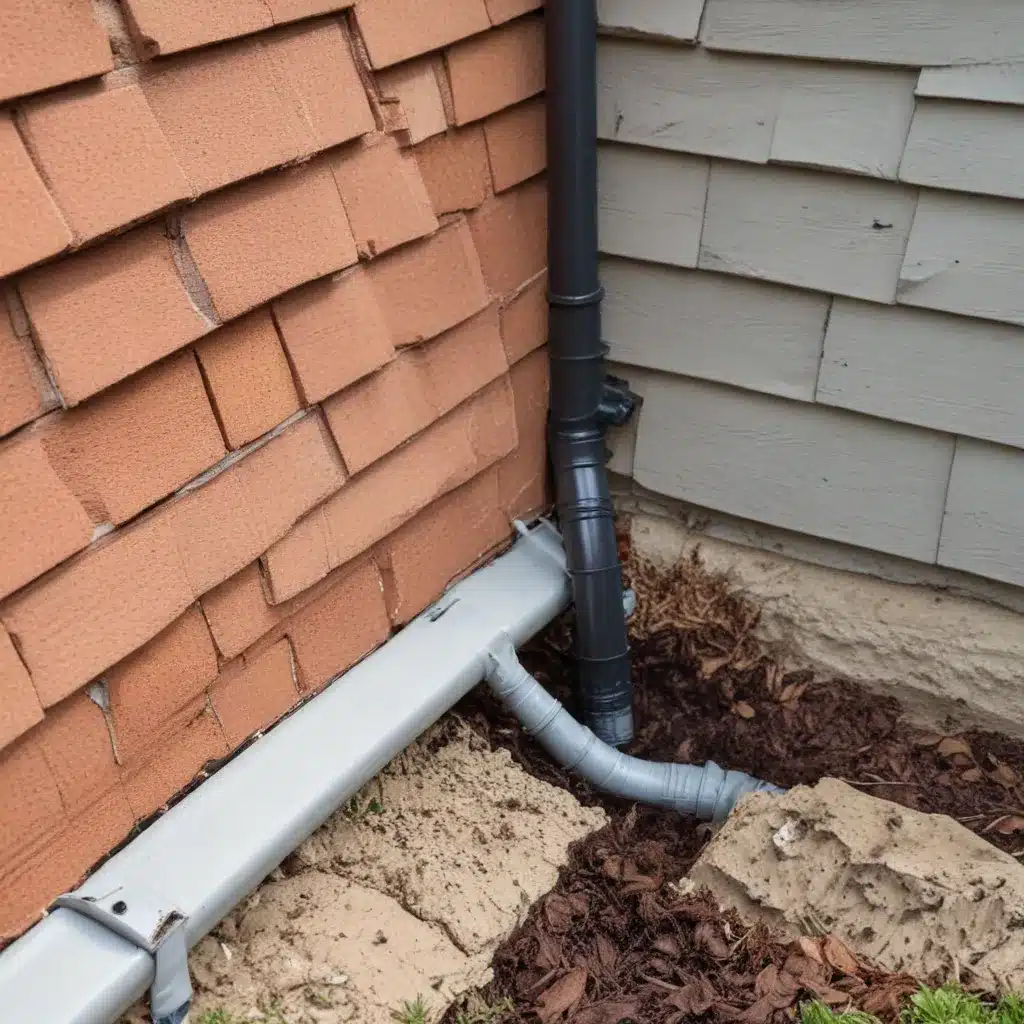
The Importance of Proper Gutter Downspout Management
As a seasoned roofing professional, I understand the crucial role that gutter downspouts play in protecting your home from water damage. Properly managing the flow of rainwater away from your foundation is essential for maintaining the structural integrity of your property and preserving the health of your landscaping.
Without effective gutter downspouts, water can accumulate around your home’s foundation, leading to a range of serious issues. One of the most immediate concerns is erosion, where the soil surrounding your foundation gradually washes away, weakening the ground that supports your home. This can result in cracks in the foundation, compromising the overall structural integrity of your entire house.
Water management isn’t just about your home’s foundation – it also helps preserve your garden, lawn, and hardscaping by preventing erosion and over-saturation. Without proper drainage, excess water can pool around your landscape, leading to erosion, root rot, and soil compaction. Over time, this can weaken plants, kill grass, and even cause damage to pathways, patios, and other hardscaped areas.
By directing water away from your home through the strategic placement of gutter downspout extensions, you can maintain a balanced moisture level, ensuring that your plants thrive and your outdoor spaces remain intact. In this comprehensive article, we’ll explore the different types of gutter downspout extensions, their typical costs, and the best practices for installation and maintenance to help you make an informed decision that protects your home and enhances your property’s overall value.
Types of Gutter Downspout Extensions
When it comes to downspout extensions, homeowners have several options to choose from, each with its own benefits depending on the specific needs of your property. Whether you’re looking for a simple above-ground solution or a more discreet underground setup, understanding the different types of extensions can ultimately help you make an informed decision that best suits your drainage needs and budget.
Above-Ground Extensions
These flexible or rigid tubes extend the downspouts away from the foundation, providing a relatively easy-to-install and adjustable solution. Above-ground extensions typically range from $10 to $50 in cost, depending on the material and length.
Underground Extensions
These French drain systems involve burying pipes that transport water away from your home, providing a long-term solution with minimal visual impact. However, they can be more expensive, ranging from $200 to $2,000, often requiring trenching for installation.
Splash Blocks
These simple, cost-effective solutions are placed at the end of downspouts to direct water away from the foundation. Splash blocks typically cost between $10 and $30 per unit, making them a budget-friendly option for improving water management around your home.
The average homeowner can expect to pay around $100 to $300 for a gutter downspout extension project, depending on the type and materials selected. Several factors can impact the overall cost, including the complexity of the installation, the need for trenching or excavation, and the quality of the materials chosen.
Choosing the Right Gutter Downspout Extension
When considering a rain gutter downspout extension installation, homeowners can choose between a DIY approach or hiring a professional. On one hand, DIY installation is often more cost-effective and gives you control over the project; however, it can require specific tools and significant time, especially for underground extensions. On the other hand, professional installation ensures the job is done correctly, particularly for complex projects like trenching, but it comes at a higher cost.
Regardless of your chosen approach, proper maintenance of gutter downspout extensions is essential for ensuring their longevity and effectiveness in directing water away from your home. Regularly inspect the extensions for blockages, debris buildup, or damage, especially after storms. Above-ground extensions typically require less maintenance but should still be checked for clogs, while underground extensions may need occasional flushing to prevent blockages.
With routine care, most gutter downspout extensions can last for many years, protecting your foundation and landscaping from water damage. Replace your extensions if they are frequently clogged, damaged, or failing to divert water efficiently. If you notice pooling near your foundation or see cracks and warping, it’s time to consider a replacement or upgrade to a more durable or longer extension. Proactive upgrades can help prevent costly damage later on.
Maintaining Gutter Downspout Extensions
To keep gutter extensions working properly, regularly check for and remove debris like leaves and dirt that can cause clogs. Flushing the extensions with a hose and inspecting them after storms will help prevent buildup. Ensure the extensions stay securely positioned to direct water away from your foundation and tighten any loose connections as needed.
The lifespan of rain gutter extensions depends on materials and installation quality. PVC and aluminum extensions typically last 5-10 years, while higher-end materials like copper can last up to 20 years. Regular maintenance can extend their longevity, protecting your home in the long run.
Conclusion: Prioritizing Gutter Downspout Extensions for Home Protection
Extending your gutter downspouts is an effective way to protect your home’s foundation and landscaping. Understanding the costs and benefits of different types of extensions will help you make an informed decision, ensuring your home remains safe from water damage.
At Roofers in Northampton, our team of experienced professionals can help you choose the right gutter downspout extension solution and provide expert installation services to safeguard your property. Contact us today to learn more and schedule a consultation.

